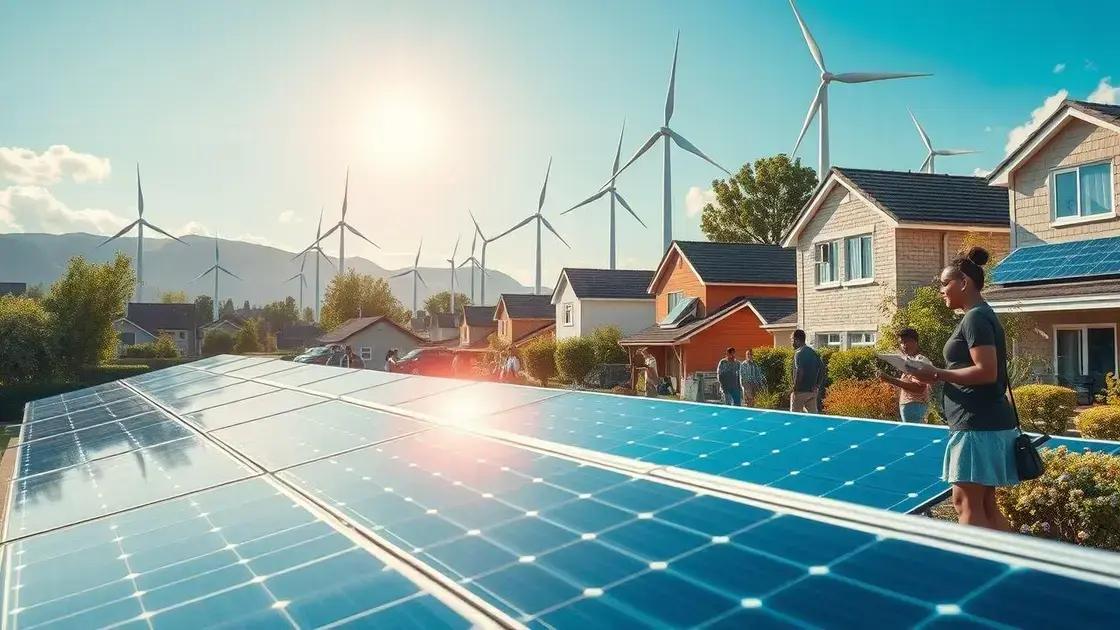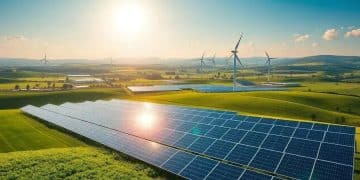Renewable energy expansion trends: what’s driving change?

Renewable energy expansion trends indicate a significant shift towards sustainable solutions driven by technological advancements, supportive government policies, and increasing public awareness, paving the way for a cleaner energy future.
Renewable energy expansion trends are gaining momentum as the world shifts towards sustainable solutions. Have you ever wondered how these trends shape our future? Let’s dive into what’s driving this change.
Understanding renewable energy sources
Understanding renewable energy sources is essential in today’s world, where sustainability is more important than ever. These energy sources are derived from natural processes that are continuously replenished, such as sunlight, wind, and water. Exploring these sources helps us understand their potential in replacing fossil fuels.
Types of Renewable Energy Sources
There are several types of renewable energy sources that contribute to green energy. Each source has its unique characteristics and applications:
- Solar Energy: Utilizes sunlight, harnessed through solar panels.
- Wind Energy: Generated using wind turbines that convert wind power into electricity.
- Hydropower: Uses moving water, typically from rivers or dams, to generate energy.
- Biomass: Involves organic materials, such as plants and waste, used for energy.
Each of these energy sources plays a vital role in achieving a sustainable future. For example, solar energy is one of the fastest-growing power sources worldwide. It is clean, abundant, and can be harnessed nearly everywhere.
Moreover, wind energy has gained significant momentum, especially in coastal areas and open plains. The development of efficient wind turbines has made it a reliable source of energy. This progress is crucial for communities looking to enhance their sustainability.
Benefits of Renewable Energy
Transitioning to renewable energy sources comes with several advantages:
- Reduces greenhouse gas emissions, combating climate change.
- Decreases reliance on imported fuels, enhancing energy security.
- Creates jobs in new energy sectors.
Moreover, renewable energy sources can lead to lower energy bills for consumers in the long run. The initial investment in technology like solar panels can pay off through energy savings, making it an appealing option.
As advancements continue, the potential for integrating these energy sources expands. For instance, combining solar panels with battery technology allows for energy storage and improved reliability. This innovation helps alleviate concerns about the intermittent nature of renewable sources. The future looks bright with renewable energy sources paving the way for a cleaner, more sustainable planet.
Current trends in renewable energy adoption

Current trends in renewable energy adoption showcase an exciting shift towards cleaner energy solutions. More countries are investing in technologies that harness the power of natural resources. With climate change concerns growing, these trends highlight the urgent need for sustainable practices.
Increased Investment in Renewables
Across the globe, governments and businesses are increasing their investments in renewable energy. This trend includes funding for solar, wind, and other green technologies:
- In 2021, global renewable energy investment reached record highs, marking a significant increase.
- Solar projects, in particular, have garnered substantial financial support due to decreasing costs.
- Wind energy has also seen rapid growth, especially in offshore installations.
As a result, many nations are setting ambitious targets to reduce their carbon footprints. For instance, countries like Sweden and Denmark are leading the way with their commitments to becoming carbon neutral.
Technological Advancements Driving Change
Technological advancements play a critical role in the adoption of renewable energy. Continuous improvements in efficiency are making these energy sources more accessible to all:
- Smart grids are optimizing energy distribution, making it easier to integrate renewable sources.
- Energy storage technologies, such as batteries, are enhancing the reliability of solar and wind energy.
- Innovative solar panel designs are improving their efficiency and reducing costs.
With these innovations, the potential for renewable energy adoption expands rapidly. This not only benefits the environment but also creates new job opportunities in the green sector.
Community adoption of renewables is another trend on the rise. Many local groups are coming together to create sustainable energy solutions that cater to their unique needs. By collaborating on solar farms or community wind projects, residents can share the benefits of renewable energy.
Policy Support and Public Awareness
Increased public awareness about climate issues is prompting governments to implement supportive policies. These measures encourage the adoption of renewable energy:
- Tax incentives and rebates for homeowners installing solar panels.
- Renewable Portfolio Standards (RPS) that require utilities to source a certain percentage of their energy from renewables.
- Funding for research and development in energy technologies.
Such policies are vital in building momentum for renewable energy adoption across various sectors. As awareness grows, more individuals and businesses are motivated to make the switch to cleaner energy alternatives. The trend towards sustainability continues to flourish, paving the way for a brighter, greener future.
Impact of government policies on renewable energy
The impact of government policies on renewable energy is profound and crucial for fostering a sustainable future. These policies provide the framework that encourages or discourages the development and adoption of renewable energy technologies. When governments commit to supporting green energy, the effects can be seen across multiple sectors.
Incentives and Financial Support
One of the most significant ways that government policies promote renewable energy is through financial incentives. These incentives can take various forms:
- Tax credits for solar panel installation, which can significantly reduce upfront costs for homeowners.
- Subsidies for wind energy projects, making them more financially viable for investors.
- Grants for research and development focused on improving renewable technologies.
Such financial support lowers barriers to entry for renewable energy systems, enabling more people to adopt these technologies.
Regulations and Standards
Governments also implement regulations that dictate how much energy must come from renewable sources. These mandates encourage utilities to invest in renewable energy projects. Various standards include:
- Renewable Portfolio Standards (RPS) which require a specific percentage of electricity to be generated from renewable resources.
- Clean Energy Standards that set emissions reductions targets for power plants.
- Environmental regulations that limit greenhouse gas emissions, thus promoting cleaner energy alternatives.
These regulations not only promote a cleaner energy grid but also stimulate job growth in the renewable sector.
International Agreements and Cooperation
International agreements, such as the Paris Agreement, also influence national policies regarding renewable energy. Countries that commit to these agreements often create domestic policies to achieve their emissions reduction goals. By participating in international efforts, governments can foster collaboration on technology sharing and best practices.
Global partnerships allow developing nations to access renewable energy technologies and expertise that they might not have otherwise. This international cooperation enhances the global transition towards more sustainable energy systems.
Public Awareness and Engagement
Government policies can also play a vital role in raising public awareness about renewable energy. By promoting educational programs and public campaigns, governments can help citizens understand the benefits of renewable energy. This increased awareness encourages individuals and businesses to support renewable energy initiatives.
As more people learn about the advantages of switching to cleaner energy sources, demand for renewable technologies rises. This shift can result in a positive feedback loop, where increased demand leads to further investment and innovation in the sector.
Future prospects for renewable energy expansion

Future prospects for renewable energy expansion look bright as technology continues to advance and public awareness grows. With the increasing urgency of climate change, there is a strong push for cleaner energy solutions. This momentum is likely to shape the energy landscape in the coming years.
Emerging Technologies
New technologies are being developed that enhance the efficiency of renewable energy sources. Innovations such as:
- Next-generation solar panels using perovskite materials, which promise higher energy conversion rates.
- Advanced wind turbine designs that can generate energy at lower wind speeds.
- Hydrogen production from renewable resources, offering a clean energy storage option.
These advancements will likely lead to greater adoption rates and lower costs for consumers.
Integration with Smart Grids
The future of renewable energy also includes better integration with smart grids. Smart grids utilize technology to improve electricity distribution, making it easier to balance supply and demand. This integration enhances the reliability of renewable sources and allows for:
- Real-time monitoring of energy usage and production.
- Seamless incorporation of renewable energy into existing power systems.
- Improved energy storage solutions that address intermittency issues.
This smart technology will streamline the transition to a greater reliance on renewable energy.
Global Collaboration and Policy Support
International collaboration will play a key role in the future of renewable energy expansion. Countries are increasingly recognizing the need to work together to address global energy challenges. Policies that encourage such collaboration may include:
- Joint research initiatives aimed at improving renewable technologies.
- Shared investment in large-scale renewable energy projects.
- Harmonization of energy standards across borders.
Such efforts can drive innovation and make renewable energy technologies more accessible worldwide.
Public Engagement and Education
As society becomes more aware of the benefits of renewable energy, public engagement will be crucial. Education campaigns that inform individuals about the advantages of renewable energy can boost acceptance and demand. Increased awareness can lead to:
- More people opting for solar panels in their homes.
- A rise in local community renewable energy projects.
- Active participation in policy advocacy for renewable energy initiatives.
The collective impact of individual actions can drive significant change in energy consumption and production practices.
FAQ – Frequently Asked Questions about Renewable Energy Expansion
What are the main types of renewable energy sources?
The main types of renewable energy sources include solar energy, wind energy, hydropower, and biomass.
How do government policies impact renewable energy adoption?
Government policies can incentivize renewable energy through tax credits, subsidies, and regulations that encourage investment and development of green technologies.
What role does technology play in the future of renewable energy?
Technological advancements improve efficiency and reduce costs, making renewable energy sources more accessible to consumers and businesses.
How can individuals contribute to renewable energy expansion?
Individuals can contribute by supporting local renewable projects, installing solar panels at home, and advocating for green energy policies.





